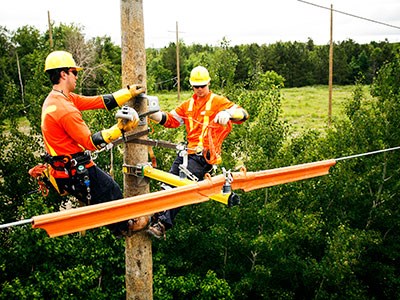A First Nations-owned transmission company is the Ontario government’s developer of choice to hook up remote communities in northwestern Ontario to the provincial power grid.
Wataynikaneyap Power LP (Watay) was selected in late July to be the transmitter to build a 1,800-kilometre network to bring power to more than 10,000 people in 17 remote communities who’ve been reliant for decades on expensive and unreliable local diesel generation.
For the last eight years, Watay and its chair Margaret Kenequanash have been leading the charge to make the $1.35-billion project a reality.
They’ve steadily grown their ownership base to 22 First Nation communities and skillfully recruited transmission specialists Fortis Ontario and RES Canada to join their consortium.
“I think it’s exciting that we’re able to bring clean energy to our communities and that we can move forward with the development that’s required to build the line,” said Kenequanash.
Construction begins in the spring of 2018 once all the necessary provincial approvals are in place, with the eventual goal of completing construction and connecting communities by 2024.
The project is expected to create almost 800 jobs.
Phase one would involve beefing up the 300-kilometre-long transmission line running into the Pickle Lake substation from 115 kV to 230 kv.
The second phase would see the line extending north of Pickle Lake and Red Lake to connect the First Nations.
Kenequanash said they’ve been in discussions with the communities in determining where the corridors can go based on the environmental sensitivity of some areas.
The next steps are to apply to the Ontario Energy Board (OEB) for ‘Leave to Construct’ the $1.35-billion project and finish all the necessary environmental assessment work.
“We’re currently working on our environmental assessment with phase one and we’re almost in completion, done our baseline studies and those things.”
Talks can now begin in earnest with the federal and provincial governments on a funding framework on how the project will be financed.
Kenequanash declined to discuss the desired public-private funding breakdown as it “pre-empts our business case and some of our negotiations that we may require in the future.”
Kenequanash said they’re setting a “huge precedent” in having ownership over such a massive infrastructure project that will improve the living situation in the communities.
Limited diesel capacity in each community represents a health and safety problem in relying on diesel.
New homes can’t be built and hooked up to utilities, and community and economic development efforts are effectively stymied as well.
“Now the communities won’t be restricted in what they can do by improving living conditions such as community infrastructure and development, and (the diesel) that compromises the health and safety of the people by way of water, food and shelter.
“That’ll turn around and enable them to pursue business and economic opportunities, create employment and training opportunities for our community members. That’s the focus of our community readiness project.
“Community readiness is a huge part of this project in order to ensure that we are ready to participate and be part of the infrastructure that we’re owning.”
Remaining on diesel generation has been a financial burden to the First Nations, which only stands to get worse.
A 2015 study by PricewaterhouseCoopers, the estimated the cost of diesel generation for these communities is $43 million annually, and growing.
Connecting the communities to the grid is said to represent $1 billion in savings over the life of the project compared to staying on diesel.
Kenequanash said the consortium remains open to presenting to, and connecting, new communities.
How their plan ties into natural resource development remains to be seen, she added.
“There’s always an option to fan out from Pickle Lake toward the Ring of Fire. Our business case does not necessarily include the Ring of Fire, but there is that option. If the communities decided to be part of that then they would be able to.”
In a statement, the provincial minister of Indigenous Relations and Reconciliation, David Zimmer, said connecting the communities “is a practical example of Ontario’s journey of healing and reconciliation with Indigenous peoples. By reducing the reliance on high-cost diesel fuel and increasing opportunities for new jobs and businesses we are helping to improve the quality of life for those who live in these communities.”
Energy Minister Glenn Thibeault said hooking up the communities goes a long way toward improving the quality of life, reducing harmful emissions and creating jobs.
“Selecting Watay Power as the transmitter for this project advances our goal of providing reliable, clean and affordable electricity for everyone in the province.”
Northern Development and Mines Minister Michael Gravelle called it “fantastic news” for the communities.
“Ensuring remote First Nation communities are connected to the energy grid will go a long way toward promoting socio-economic developments for the communities and their residents.”




